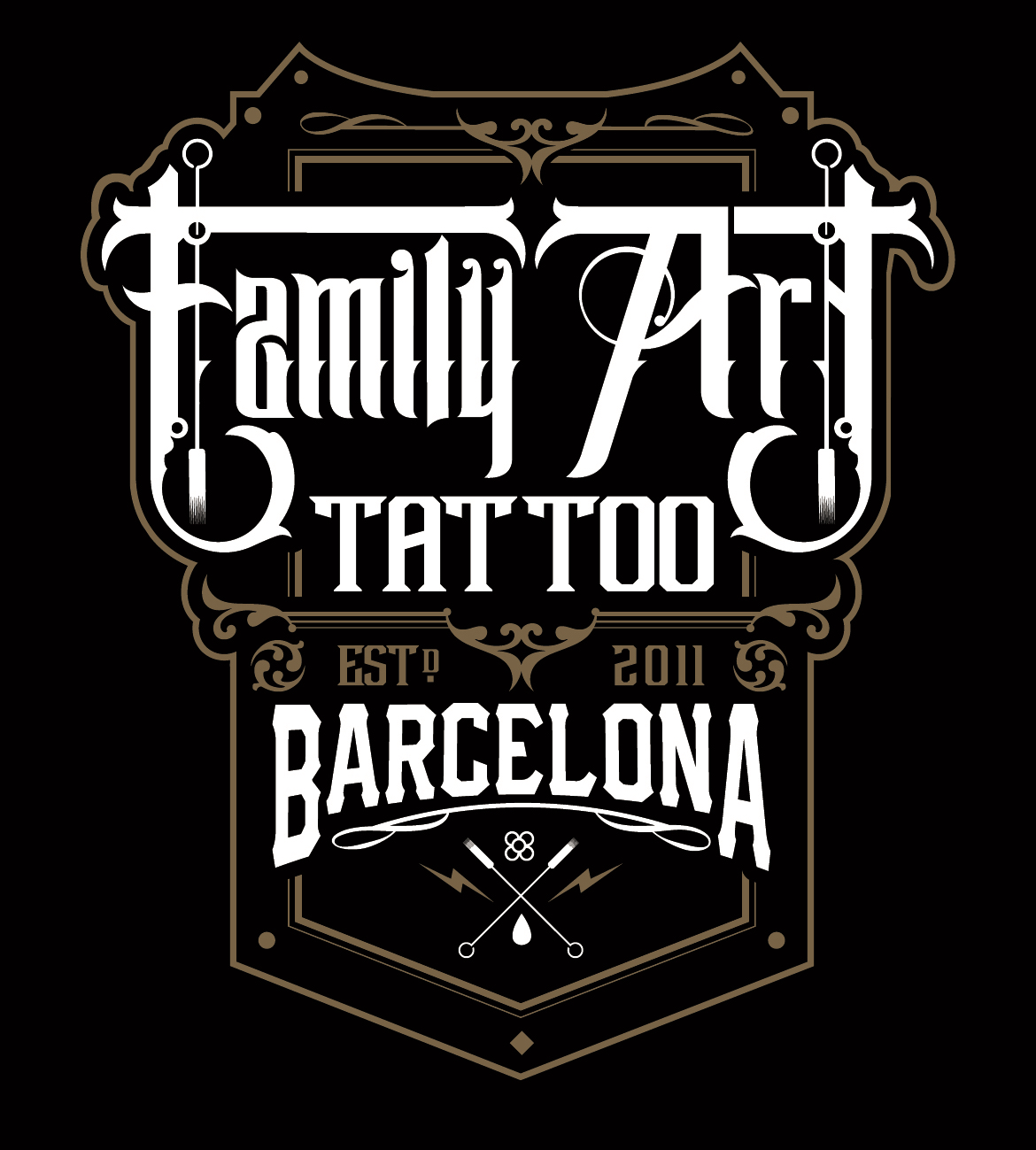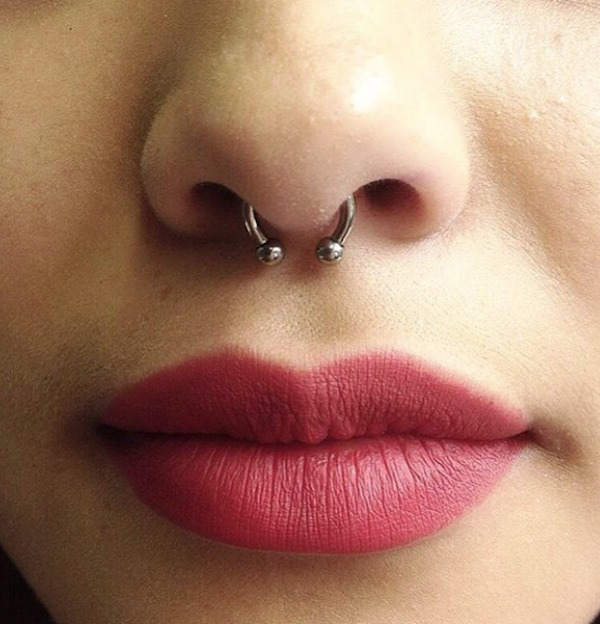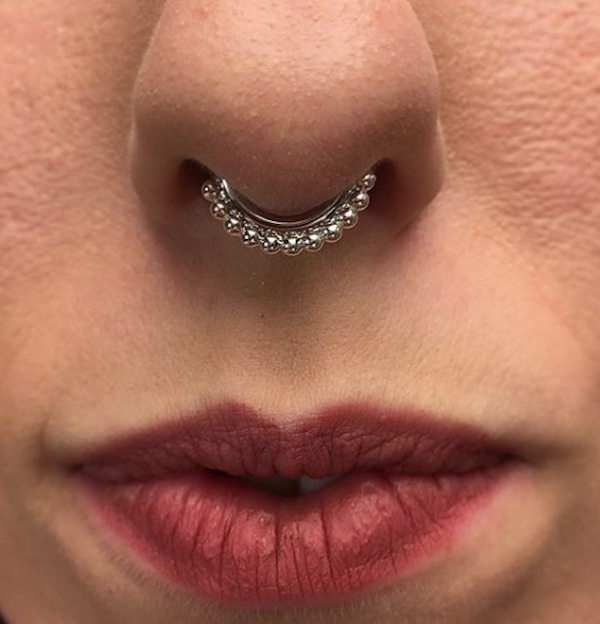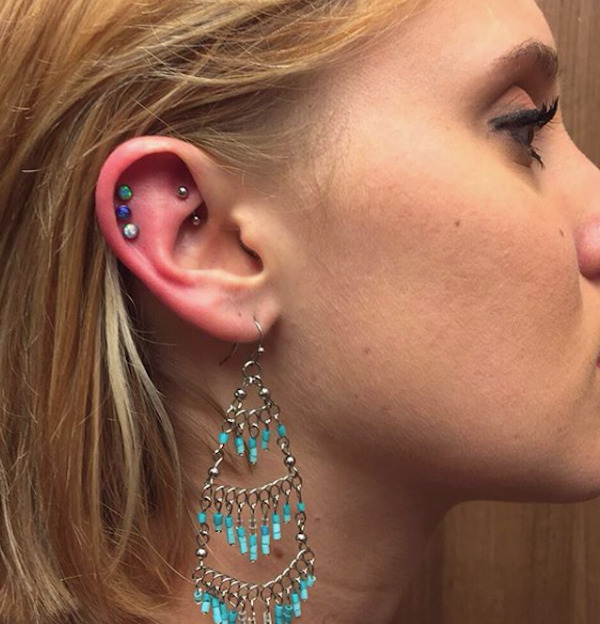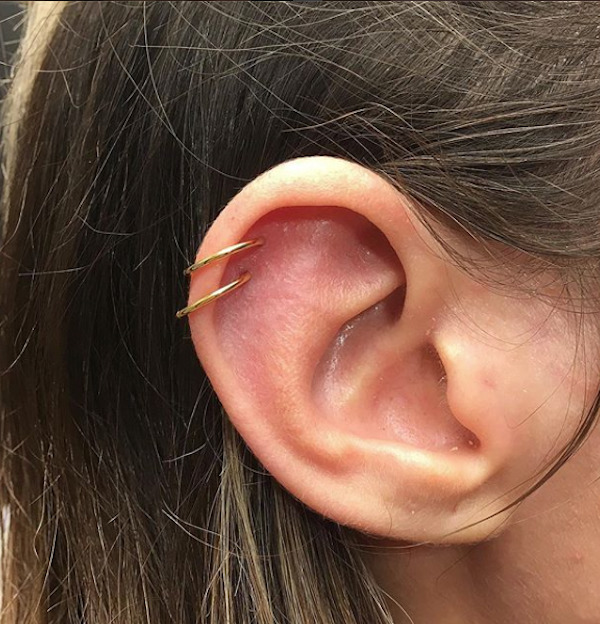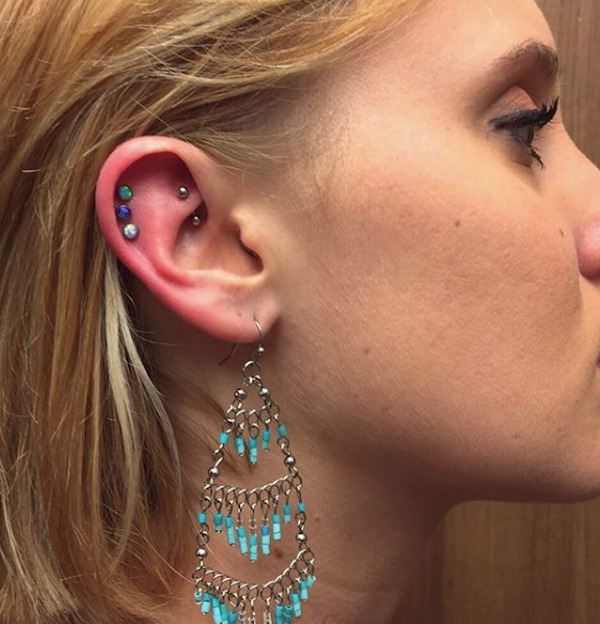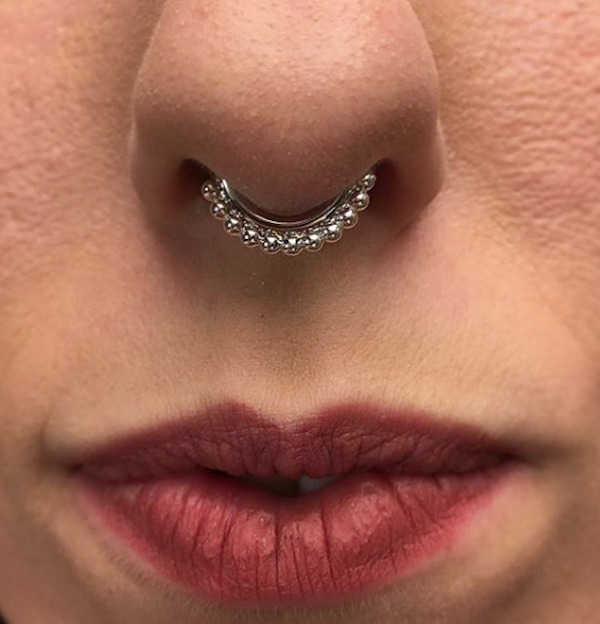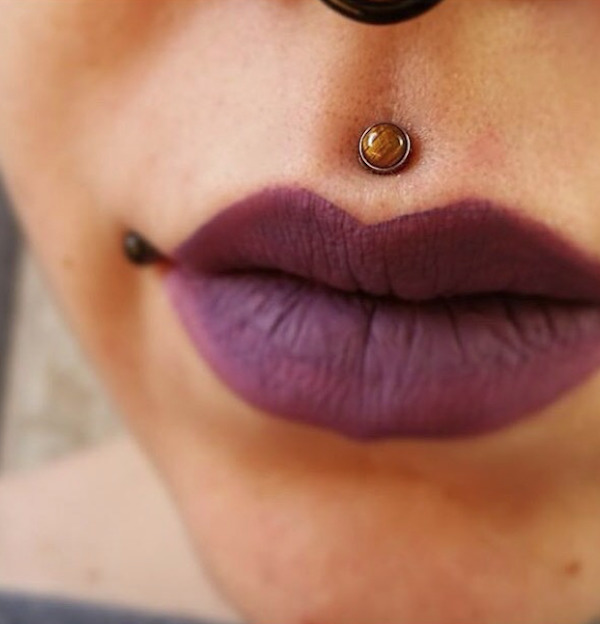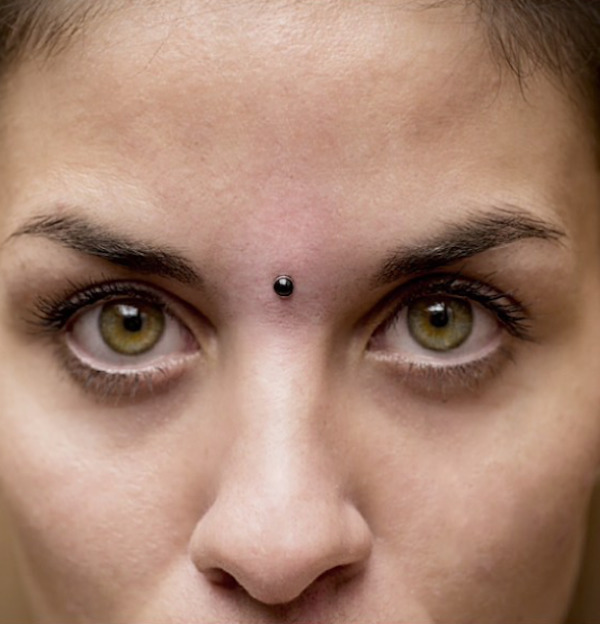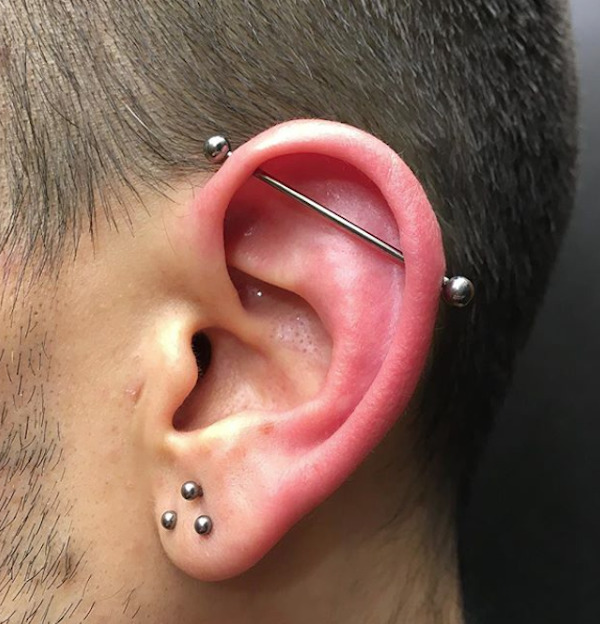The art of drilling
Getting a body modification such as a piercing can often be both an intimidating and exciting experience. It is normal that you like to do something to yourself from time to time. But this does not mean that it is an activity to be taken lightly. Taking care of your body is very important and each body modification requires a specific type of care. Otherwise, they can damage the work you’ve done or worse, get infected and sick. Like any art, body modifications must be taken seriously.
Before getting a piercing, it is important to seek out an experienced and qualified professional at a reputable piercing studio to minimize the risks of complications or infection.
Instagram de nuestra piercer
Marta Korrotxano
Aftercare
What to expect in the early stages of healing…
During the first few weeks of healing, it’s likely that you will experience the following:- Localised swelling, localised pain and tenderness, discharge of a clear our cloudy fluid, bruising and bleeding.
Discharge of a clear or cloudy fluid may persist for several months with slow healing piercings.
These are very normal, you may experience none, some or all to a degree and still have a very healthy piercing. DO NOT touch, pick at, twist or apply cosmetics to your piercing. Please read this page carefully and follow the cleaning instructions listed as advised.
Sterile Saline
Sterile 0.9% Saline is an isotonic solution, this means it neither over hydrates or dehydrates your skin, to cause minimum disruption to the wound healing process.
This is why it’s so important to not use soaps, oils and alcohol based products. They are not isotonic and will cause disruption to this type of wound healing.
Wash your hands
You must wash your hands before and after you clean your piercing to prevent the spread of infection. If you do not wash your hands prior to cleaning, you may be actively transferring harmful bacteria onto your piercing as your cleaning it.
How often?
Piercings should only be cleaned with sterile saline once or twice a day. Over cleaning will cause disruption to wound healing and under cleaning may cause infection.
About how long that depends of each piercing and person follow the instruction the piercer give you in your checkins during the process.
How should I apply it?
Test your sterile saline stream by spraying it once into the sink before using it on yourself to help gauge the pressure of the flow – you can usually hold your canister a couple of inches away from your piercing. Concentrate the flow at the piercing exit wounds at the front and the back. It will only take seconds seconds to rinse your piercing. Do not remove your jewelry and DO NOT TWIST YOUR PIERCING as this disrupts the formation of new skin cells, delaying healing and potentially causing a bump and possibles infection and inflammation.
Drying your piercing
As soon as your piercing as been cleansed whether with sterile saline or in the shower you must gently dry the skin. The best material for this is lint free gauze, which is inexpensive and will not leave little bits of cotton fluff at the wound site. If this is not available to you, you can use cotton wool, disposable kitchen towel, or a cotton bud, whichever you feel is the most accessible to the wound site.
DO NOT USE makeup remove wipe, towel or toilet paper as it dissolves on contact with moisture and will leave the most particulate matter on your piercing.
Showering
Showering is an excellent way to clean your piercing, the constant stream of clean warm water will help remove dry exudate – the waste material that discharges from your piercing. Be careful not to use a loofah or shower pouf on or around your piercing in case of snagging, they also harbor bacteria.
Downsizing
Si en tu perforación no hay un eje visible significa que la inflamación no a bajado por lo tanto no se puede cambiar. Es necesario poder ver el eje de la joya eso es síntoma que a bajado la inflamación por lo tanto momento de hacer un cambio de tamaño.
Healing tips and tricks
There are no tricks that will help your piercing heal faster, but you can help your piercing heal easier by doing the following:
- DO return to the shop and have your piercing downsized after a few weeks if you have no swelling and your jewelry is too long.
- DO change your bedding regularly
- DO wear clean, comfortable lose fitting closing if covering the wound site
- DO drink lots of water, dehydration will slow and prevent wound healing
- DO rest and eat vitamin rich foods
- DO NOT sleep on your piercing until after it is downsizes at the very earliest.
- DO NOT recommend go swimming, jacuzzi, sauna while your piercing is healing or for a minimum of 3 months for slow healing piercings such a cartilage, surface, nipple and navel piercings.
- DO NOT touch or allow others to touch your piercing. Handle your piercing only when necessary for aftercare with hands that have just been washed with warm soapy water.
- Disinfect regularly any personal items that might come into contact with your piercing regularly such as your glasses. Restrict the use of personal items such as your phone or headphones and disinfect these items regularly. If you have healing piercings on one ear, use your phone on the other ear.
- Cut down on drinking and smoking as both of these things slow down the wound healing process and leave you exposed to potential complications for longer.
FAQ
¿Cuántos PiercingHow many Piercings can I have done in an appointment?
We will not recommend more than 3 ear, cartilage, body, or facial piercings or any combination of them in a quantity of more than 3. We recommend waiting at least 6 weeks in between appointments to allow for the initial swelling and tenderness to pass before having more work done to make after care manageable and mitigate infection risk. . We recommend that you work on one ear at a time when having cartilage piercings performed, to leave yourself one side to sleep on, however if we can offer this service safely with your informed consent we will.
At what age can I get a piercing?
At the age of 18, you can get any type of body piercing that is suitable for your health.
From 16 to 18 years old, we do not do piercing in genital areas, nipples, tongue, surface, microdermal. If you are in this age range you will have to come accompanied by a father, mother or legal guardian and present ID of each one in addition to completing the informed consent.
For children under 16 years of age, we only pierce the area of the earlobe. If you are in this age range you will have to come accompanied by a father, mother or legal guardian and present ID of each one in addition to completing the informed consent.
Perforations for children are performed from the age of 10 only in lobes accompanied by a father, mother or legal guardian and present the ID of each one in addition to completing the informed consent.
We do not pierce newborn babies.
Can I get pierced on a site where I have had cosmetic surgery or filler?
Cosmetic surgery is very common and can be performed for a variety of essential and non-essential reasons and can include procedures such as ear lobe reconstruction, breast augmentation, rhinoplasty and tummy tucks. All surgery will cause scar tissue, which can cause healing complication in piercing which in turn can cause more scar tissue. You should wait a minimum of 12 months to allow for scar maturation to take place before attempting to be pierced on or near a surgery site. Your doctor may tell you the you are “cleared” sooner than this, however this doesn’t change the fact that scar maturation takes at least 12 months.
We do not pierce and do not recommend that you ever attempt to pierce sites that contain filler such as the lips or cheeks, as this can result in filler seepage, rejection and may also exacerbate infection due to the presence of a foreign body spread through internal tissues. We recommend you wait until your filler dissolves, have the piercing you want done, wait for it to heal fully and then start having filler done again if you wish as a healed piercing channel or “fistula“ will help protect you from these potential side effects.
Can I Bring my own Jewelry?
No, we only perform fresh piercings with never before worn jewelry purchased at Family Art on the day of your piercing.
If you would simply like your jewelry changed in a healed piercing we can do that for you as long as the jewelry was purchased at Family Art Tattoo.
We do not insert any jewelry bought online or in another studio
Why can’t you pierce me with jewelry I’ve already worn?
All jewelry arrives at Family Art are new and unworn and we then sterilize it on site in a clean facility. As only clean jewelry is processed in this space, if we take your jewelry which has been exposed to your bodily fluids and bring it into that clean environment we are contaminating that space.
The jewelry used ends up getting damaged over time and its surface can be affected. This affects the healing of a new piecing.
Therefore, we do not accept jewelry from outside to avoid contaminating the clean sterilization area and to avoid working with inappropriate materials, measurements and polishing for new piercings.
How do I care for my jewelry?
The jewelry we pierce you with is implant grade, what that means is that it’s biocompatible and will not break down over time when exposed to the heat and moisture of your body. Implant grade jewelry is not affected by things like showering, but exposure to harsh chemicals, for instance peroxide in hair dye, may tarnish solid gold or anodised jewelry. When wearing gold jewelry please remember this is a soft metal, and like a delicate chain it can break is pressure or force is applied to it. This is another good reason to have your initial piercing post downsized to help minimise the risk of “snagging“ your piercing.
What is your jewelry sales policy?
Jewelry can not be returned or exchanged for hygiene purposes.
What kind of jewelry do you use?
We pierce with implant grade titanium ASTM F-136, stainless steel ASTM F-138. We also pierce with 14 and 18 karat gold rings and attachments on titanium posts. We are are extremely selective not only with the materials we use but the surface finish and overall craftsmanship of the jewelry too.
¿Que me recomiendas antes de hacerte tu piercing ?
* Si tiene muchas preguntas que hacer antes de hacerse la perforación, no dude en enviar un correo electrónico a la tienda a familyasttattoo@gmail.com o contacte directamente con la piercer por Instagram @marta_korrotxano antes de su cita y le responderemos todo lo que podamos con anticipación, esto ayuda a maximizar su tiempo en la tienda para hácer la perforación ya que las citas se establecen en bloques de tiempo.
Is there anything I should do to prepare?
- If you have many questions to ask prior to getting pierced, please feel free to email the shop at familyarttattoo@gmail.com or contact directly with the piercer on Instagram @marta_korrotxano before your appointment and we will answer as much as we can in advance, this helps to maximise your time in store to browse jewelry and have the piercing done as the appointments are set blocks of time.
- Please cancel your appointment if you feel sick. For cancellations 24 hours before your appointment.
- Make sure you have had something to eat or drink at least 4 hours prior to your appointment.
- Do not abuse drugs or alcohol before your appointment.
- Do not get pierced if you are about to go on a holiday where you may be swimming or may not have access to clean running water.
- Do not get pierced if you know you may have to remove your jewelry before it has healed for work/school purposes.
Do you offer numbing?
No we don’t offer numbing and we don’t recommend you attempt any personal numbing at home before your appointment either. A piercing is similar to getting an injection at the doctor or dentist – it’s not nice, but it takes 2 seconds and then it’s over. Numbing products are medical products and do pose a risk in terms of allergens and skin irritations, they also “vasoconstrict“ which means they starve the skin of blood which is harmful to a new piercing because a strong healthy blood flow is needed to start the healing process. In addition, numbing products can contort the skin, so we could mark a certain placement on you and hours later as the numbing product wears off the piercing placement could relax and shift. In summary – piercings hurt, we don’t like it but it is part of the experience and we’re hear to make that process as quick and easy for you as possible.
Can I be pierced when I am pregnant or breastfeeding?
No new piercings can be performed while you know yourself to be pregnant or believe you may be pregnant. This is because piercings are a voluntary procedure that can result in infection. We cannot knowingly pierce any pregnant person and are not permitted to do so by our local authority or insuring body.
When it comes to breastfeeding, our local authority and insuring body do not permit us to pierce breastfeeding parents, however if you have ceased breastfeeding we are permitted to pierce you and if you are looking to have your nipple pierced specifically we suggest waiting for 6 months from the point at which you have ceased breast feeding to have your nipples pierced to allow the nipple time to stabilise as breastfeeding can change the size and shape of your nipple.
How long do I have to wait after being pregnant to get pierced?
We recommend waiting 6 months postpartum before having any new piercings performed, this is regardless of whether or not you have chosen to breastfeed. In the event you have suffered a miscarriage: if you have been through a still birth, vaginally or through cesarean section, please also give yourself a minimum of 6 months to allow your body to recover. If you have suffered a miscarriage prior to 24 weeks and/or have not been through the birthing process with your baby, you may still have pregnancy hormones in your body for up to 2 months, our recommendation is to wait 3 months in this instance before having any new piercings performed to allow your hormonal balance time to stabilise.
If you have undergone an outpatient termination of up to 10 weeks, please wait either 2 months or until your next period (whichever comes first) to be pierced again, if you have undergone an inpatient surgical termination our recommendation is to wait 3 months before having any new piercings performed.
Will my pregnancy affect my current piercings?
Potentially yes, it is a common phenomenon that during pregnancy pre-existing piercings can flare up and become sore. There are a few reasons for this. Significant hormonal changes can cause your skin to become oilier or dryer than usual which may irritate your existing piercings. For some this may only be a minor phase during their pregnancy and not one that requires piercing to be removed.
Pregnancy can also trigger allergies that were previously not currently active, so for example if you have a piercing you’ve worn jewellery in for years that contains nickel, it may never have bothered you before but pregnancy could trigger that allergy and the piercing may become inflamed. If your piercings become irritated enough the skin may break down leaving you open to infection, so for some having longer, implant grade jewelry fitted may help.
As your pregnancy progresses you may find your navel jewelry becomes uncomfortable to wear or that your nipple jewelry becomes too tight. If you have genital piercings you may find they also might become tight or uncomfortable as the vulva will increase in size when you come near the end of your pregnancy as the body produces significantly more blood in the run up to childbirth which can cause vascular areas to enlarge.
This increase in blood production can also cause your temperature to rise significantly, and overheating can also cause piercings to become irritated through increased sweating and tossing and turning at night. For some, retiring existing piercings may be the safest option. For example if you are planning to breastfeed you should retire your nipple piercings as it is a choking hazard to place nipple jewelry into your infants mouth no matter how tightly it’s believed to be on. Genital piercing jewelry is often required to be removed prior to giving birth in the event of emergency so it does not interfere with the work of medical professionals.
It is still possible to have jewelry removed or replaced during pregnancy however we are unable to remove dermal anchors as this would be considered a skin breaking treatment, for this reason dermal anchor removal during pregnancy should only be conducted by a medical professional as it would be a violation of our studio licence.
